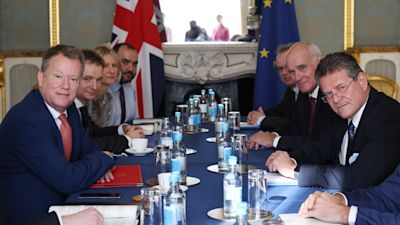Explainer
Brexit: What is the Article 16 'get-out clause' and what happens if the UK triggers it?

To some in Northern Ireland, Brexit Britain increasingly looks like a foreign country. The so-called ‘Protocol’ is a political term for what is effectively a new border that now splits the UK down the Irish Sea - separating Northern Ireland from England, Scotland, and Wales. That is unacceptable to Northern Ireland’s Unionist and Loyalist communities because it threatens the very British identity they have fiercely defended for a century now, sometimes with violence. They say the Protocol has been done to them without their consent. The UK Government is also unhappy with how the Protocol is functioning for trade and laws, and they now want a rewrite of the whole agreement.
What is Article 16?
There is an option to backtrack on the deal that delivered the Protocol by triggering ‘Article 16.’ Article 16 is a mechanism that offers both the UK and the EU a get-out clause - a chance to unilaterally scrap the way the Protocol is working and apply emergency “safeguard” measures. This can only be done if it is perceived that the Protocol is fundamentally not working for either party - the agreement cites “serious economic, societal, or environmental difficulties” as cause for Article 16. The UK Government believes that threshold has been reached in Northern Ireland; the EU disputes this. The UK Government also says it “would not go down this route gratuitously or with any particular pleasure”. The Irish Government has warned the UK that it would be “reckless”. Yet there is increasing expectation that Article 16 is about to be activated by the UK in the coming weeks.
The border question The Protocol is what answered the delicate question of ‘where is the least bad place to put a new border between the UK and the EU after Brexit?’ A border of some sort is necessary because the UK has left both the EU’s single market and the customs union. It is accepted this means there must be a point somewhere for the EU to apply checks and controls to monitor what ‘outside’ goods are allowed in.
The UK also wanted to control its own borders independently, which was a key promise in the Brexit referendum. The UK’s actual border with the EU is between Northern Ireland and the Republic of Ireland.
However, the UK and EU were in agreement that putting a border on land in the island of Ireland would be unwise, partly because it would be too porous to control effectively, but mainly because it of the threat it could undermine Northern Ireland’s peace deal. The Good Friday Agreement of 1998 that finally ended decades of fighting in Northern Ireland has, as one of its cornerstones, the principal of allowing people in Northern Ireland to identify as either British or Irish. Putting hard-border infrastructure through Ireland would represent a symbolic retreat from that - anathema to Irish republicans and nationalists who pursue the goal of a united Ireland.
There were warnings from the Police Service Northern Ireland that any border infrastructure or border guards trying to enforce this would be a target for armed republican dissidents. In the Protocol agreement, the UK and EU opted instead to put checks at sea ports in Northern Ireland, effectively creating a border down the Irish Sea - perceiving as the less risky option.
What's wrong with the Protocol? The Protocol is a bit of a political fudge, officially it means Northern Ireland is allowed to be the only part of the UK that remains still inside the EU’s single market, and still subject to the European Court of Justice.
In practice, it means certain goods coming in to Northern Ireland from other parts of the UK, such as eggs, meat, and medicine, are now subject to stops and checks. These goods and the hauliers carrying them are treated as though they are leaving the UK and entering the EU. In Northern Ireland, of all places, that really matters.
“The Protocol is the de-Britishisation of Northern Ireland,” one former loyalist paramilitary told me. Another loyalist told me there is resentment that republicans threatened violence and got their way. “If it’s a case of whoever barks loudest gets their way, then we can bark too,” he says. In recent weeks, two buses in Northern Ireland have been hijacked and set alight - the attackers have cited the Protocol as their motivation.
What happens now? If Article 16 is activated, it does not mean the entire Brexit deal collapses. It means there is a break in agreement on how the Protocol is applied. The UK wants the EU to accept a more light-touch approach to goods going in for use in Northern Ireland only. How that is to be enforced has not yet been spelled out. The EU has offered concessions and there are warnings from Brussels that patience is wearing thin. The EU could retaliate with a trade war or legal action, but sources in the Irish Government tell me they are keen not to speculate because Article 16 should not be viewed as a formality. As with all things Brexit, this is likely to go right down to the wire. If Article 16 is triggered, a month’s notice is expected before the emergency get-out clause comes in. But the EU hasn’t given up trying to convince the UK to stick with it. Their chief negotiator, Maros Sefcovic is meeting his UK counterpart Lord David Frost to make a plea for political solutions.